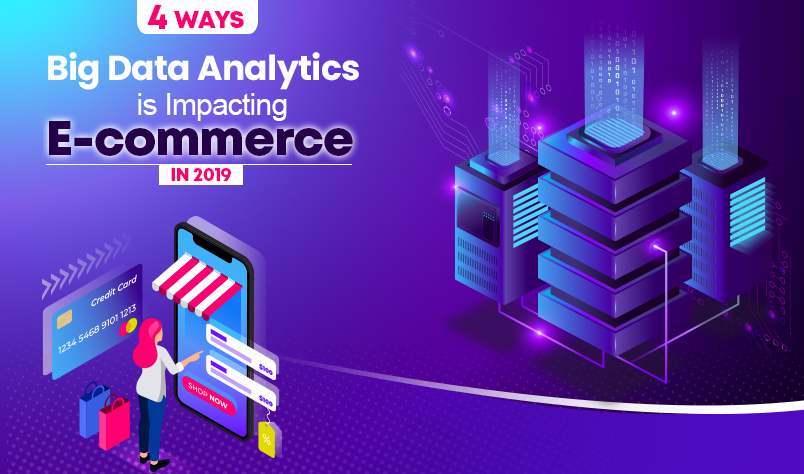Toggle navigation

E-commerce is burgeoning.
The deluge of smartphones and other electronic devices, coupled with a rise in disposable incomes, has contributed massively to the rising numbers of digital shoppers.
In India, the e-commerce market has more than tripled since 2015 and continues to grow unabated with the rise in internet penetration.
E-commerce giants like Flipkart, Amazon and Paytm have invested millions in technology to create a more personalized user experience. Big Data analytics has emerged as an enabler for such e-commerce retailers in several ways:
1) Demand forecasting: Demand forecasting has become more important than ever before, and the reasons are obvious:
Fluctuations in demand and supply have become more frequent.
Inventory stocking has always been a challenge for e-commerce players. They understock and miss out on an opportunity of selling. They overstock and risk not being able to sell it all.
So, how does Big Data analytics help here?

E-commerce retailers use predictive analytics to analyze all historical sales data, seasonal fluctuations and other trends. The rope in all possible factors that can affect demand, such as holidays, festivals, political events, climatic changes, fashion fads etc. and forecast demand accordingly.
For example, if winters are expected to arrive early, customers may rush to buy their winter supplies in November instead of December. If an online seller has taken the weather forecast into consideration, he can sell more winter wear and gain an edge over his competitors.
Retailers can now track their website traffic in real-time and predict conversion rates at any point in time.
What else can predictive analytics do?
It can predict trends. It can analyze what’s buzzing on the internet and social media channels.
Data scientists can now analyze online ads to check what other companies are trying to market.

They can analyze mentions of a product on the internet and check if these are positive, negative or neutral. They can accordingly predict if the demand for a particular product or category will rise, fall or stay constant.
For example, a cosmetic retailer launches a fairness product in the market. The retailer employs data scientists to carry out a sentiment analysis on the reviews of the product on social media channels and find out if these reviews are positive or negative.
Reviews that contain words like happy, great product, satisfied, recommend, value for money, etc. will be marked positive. Reviews containing words like pathetic, disgusting, terrible, never buy again, etc. will be considered negative.
2) Personalized Shopping Experience: The e-commerce space is fiercely competitive. This competition makes it imperative for every retailer to create a highly personalized shopping experience for its customers.
Big data analytics and machine learning allow retailers to use a customer’s historical buying behaviour and personal preferences to customize their shopping space.
In fact, 87% of shoppers believe they are driven to buy more when online stores personalize their shopping experience.
To understand how personalized shopping experience works, let us consider the following examples:
1) A customer goes to an e-commerce site, adds a pair of shoes and a jacket to her shopping cart. She, however, does not complete the transaction and abandons the cart for some reason. She purchases from this site frequently, so the system knows that the customer is valuable. Now, the system reacts immediately and offers her a discount coupon on the purchase of the jacket and prompts her to complete the transaction.
2) A customer browses an e-commerce site and searches for leather handbags but does not buy anything from the site. The customer has bought high-value items from the site in the past, so the system considers her valuable. Two days later, she receives a personalized e-mail from the company announcing the arrival of new leather handbags. This mail may prompt her to revisit the site and consider buying from it.
Amazon has been the undisputed market leader when it comes to creating a personalized shopping experience for any customer. Amazon does this in several ways:
If a user clicks on an item, say a mobile phone, the system recognizes the item searched and a ‘Frequently bought together’ section appears on the page as shown below.

In the above picture, the ‘Frequently bought together’ section shows a mobile back case cover bundled with the phone. This may prompt the user to buy both the items as he sees more value in buying the bundle instead of just one item.
When the user scrolls down further, the page shows a ‘Customers who bought this item also bought’ section (see figure below) based on what other customers purchased with that mobile phone. Then there is a section ‘Sponsored products related to this item’ which are PPC advertisements that show similar products (mobile phones in this case). These sections give a peek into Amazon’s powerful machine learning algorithms running in the background.

Scrolling down further, the user sees a ‘Your recently viewed items and featured recommendations’ section based on his past purchases, search history, items added to the shopping cart, etc.
The home page of Amazon is also hyper-personalized and has sections that show discounted items for that day, best sellers in different categories, recommendations for the user, etc.
Besides, Amazon also offers options such as one-click checkout, where any user can conveniently checkout using a single click as his payment and shipping information are already stored on the site.
Even if the user leaves the site, he will see Amazon ads based on his search history on other webpages.
3) Dynamic Pricing: Dynamic pricing is the practice of offering products at flexible prices.

Several prominent e-commerce retailers now practice dynamic pricing.
Dynamic pricing benefits e-commerce sites in several ways:
Dynamic pricing uses machine learning algorithms that consider several variables simultaneously to optimize price for a product in real-time. Some key variables are:
Amazon has been the pioneer in the dynamic pricing space.
Amazon reportedly changes product prices 2.5 million times a day which means the price of any product changes every ten minutes on an average.
According to Amazon, its prices change based on company meetings or beating the lowest price from other online retailers.
Interestingly, dynamic pricing has helped Amazon devise one useful strategy, and that is to beat its competition on popular products while raising the price of uncommon products.
So, when customers compare the prices of common products, they find them cheaper on Amazon and end up believing that Amazon has the best overall prices. This way they end up buying more often from Amazon and pay more for less popular stuff they buy from Amazon.
Walmart and other retailers have followed in the footsteps of Amazon and switched to dynamic pricing to stay in the competition.
4) Customer service improvement: Apart from providing a highly personalized experience (discussed above), Big Data analytics helps e-commerce retailers monitor and analyze customer feedback across all channels.
They get customer feedback through channels like feedback surveys, SMS, call transcripts, and chats. They can analyze this feedback through analytical algorithms to gain a comprehensive view of customer sentiment and improve accordingly.

For example, if an e-commerce brand finds that the many of its customers add products to their cart but do not check out, the brand can analyze the data collated through various feedback channels to find the reasons behind their doing so.
E-commerce players can monitor discussions on social media to find out what customers are saying about them, what concerns customers have with respect to their products, quality of service, etc. They can identify which channels are the most popular among customers so that they can staff these channels appropriately.
They can connect with customers through their preferred channel of communication and keep them informed about any new offers, discounts, product dispatch, etc. The customers don’t need to check for any information.
The Bottom Line
E-commerce is booming, thanks to the advancement in data-driven technology. E-commerce retailers can now track figures in real-time, predict trends, forecast demand and create a highly personalized customer experience. Given the ease with which e-commerce is operating now, the coming decades might witness another sharp decline in traditional brick-and-mortar stores.
Leave a Reply